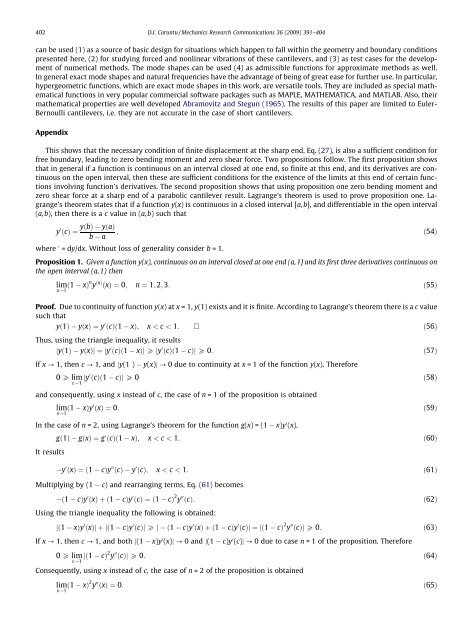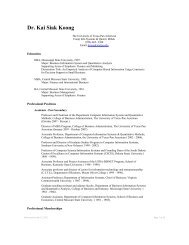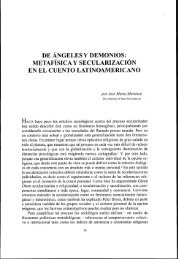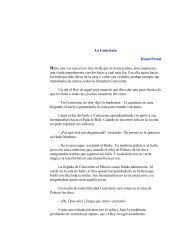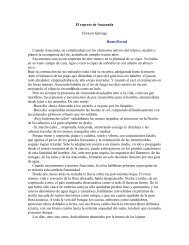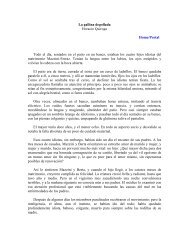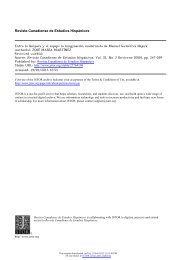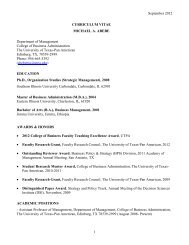Dynamic modal characteristics of transverse vibrations of cantilevers ...
Dynamic modal characteristics of transverse vibrations of cantilevers ...
Dynamic modal characteristics of transverse vibrations of cantilevers ...
Create successful ePaper yourself
Turn your PDF publications into a flip-book with our unique Google optimized e-Paper software.
402 D.I. Caruntu / Mechanics Research Communications 36 (2009) 391–404<br />
can be used (1) as a source <strong>of</strong> basic design for situations which happen to fall within the geometry and boundary conditions<br />
presented here, (2) for studying forced and nonlinear <strong>vibrations</strong> <strong>of</strong> these <strong>cantilevers</strong>, and (3) as test cases for the development<br />
<strong>of</strong> numerical methods. The mode shapes can be used (4) as admissible functions for approximate methods as well.<br />
In general exact mode shapes and natural frequencies have the advantage <strong>of</strong> being <strong>of</strong> great ease for further use. In particular,<br />
hypergeometric functions, which are exact mode shapes in this work, are versatile tools. They are included as special mathematical<br />
functions in very popular commercial s<strong>of</strong>tware packages such as MAPLE, MATHEMATICA, and MATLAB. Also, their<br />
mathematical properties are well developed Abramovitz and Stegun (1965). The results <strong>of</strong> this paper are limited to Euler-<br />
Bernoulli <strong>cantilevers</strong>, i.e. they are not accurate in the case <strong>of</strong> short <strong>cantilevers</strong>.<br />
Appendix<br />
This shows that the necessary condition <strong>of</strong> finite displacement at the sharp end, Eq. (27), is also a sufficient condition for<br />
free boundary, leading to zero bending moment and zero shear force. Two propositions follow. The first proposition shows<br />
that in general if a function is continuous on an interval closed at one end, so finite at this end, and its derivatives are continuous<br />
on the open interval, then these are sufficient conditions for the existence <strong>of</strong> the limits at this end <strong>of</strong> certain functions<br />
involving function’s derivatives. The second proposition shows that using proposition one zero bending moment and<br />
zero shear force at a sharp end <strong>of</strong> a parabolic cantilever result. Lagrange’s theorem is used to prove proposition one. Lagrange’s<br />
theorem states that if a function y(x) is continuous in a closed interval [a,b], and differentiable in the open interval<br />
(a,b), then there is a c value in (a,b) such that<br />
y 0 yðbÞ<br />
ðcÞ ¼<br />
b<br />
yðaÞ<br />
;<br />
a<br />
ð54Þ<br />
where 0 =dy/dx. Without loss <strong>of</strong> generality consider b =1.<br />
Proposition 1. Given a function y(x), continuous on an interval closed at one end (a,1] and its first three derivatives continuous on<br />
the open interval (a,1) then<br />
limð1<br />
xÞ<br />
x!1 n y ðnÞ ðxÞ ¼0; n ¼ 1; 2; 3: ð55Þ<br />
Pro<strong>of</strong>. Due to continuity <strong>of</strong> function y(x)atx =1,y(1) exists and it is finite. According to Lagrange’s theorem there is a c value<br />
such that<br />
yð1Þ yðxÞ ¼y 0 ðcÞð1 xÞ; x < c < 1: ð56Þ<br />
Thus, using the triangle inequality, it results<br />
jyð1Þ yðxÞj ¼ jy 0 ðcÞð1 xÞj P jy 0 ðcÞð1 cÞj P 0: ð57Þ<br />
If x ? 1, then c ? 1, and jy(1 ) y(x)j ? 0 due to continuity at x = 1 <strong>of</strong> the function y(x). Therefore<br />
0 P lim jy<br />
c!1<br />
0 ðcÞð1 cÞj P 0 ð58Þ<br />
and consequently, using x instead <strong>of</strong> c, the case <strong>of</strong> n = 1 <strong>of</strong> the proposition is obtained<br />
limð1<br />
xÞy<br />
x!1 0 ðxÞ ¼0: ð59Þ<br />
In the case <strong>of</strong> n = 2, using Lagrange’s theorem for the function g(x)=(1 x)y 0 (x).<br />
It results<br />
gð1Þ gðxÞ ¼g 0 ðcÞð1 xÞ; x < c < 1: ð60Þ<br />
y 0 ðxÞ ¼ð1 cÞy 00 ðcÞ y 0 ðcÞ; x < c < 1: ð61Þ<br />
Multiplying by (1 c) and rearranging terms, Eq. (61) becomes<br />
ð1 cÞy 0 ðxÞþð1 cÞy 0 ðcÞ ¼ð1 cÞ 2 y 00 ðcÞ: ð62Þ<br />
Using the triangle inequality the following is obtained:<br />
jð1 xÞy 0 ðxÞj þ jð1 cÞy 0 ðcÞj P j ð1 cÞy 0 ðxÞþð1 cÞy 0 ðcÞj ¼ jð1 cÞ 2 y 00 ðcÞj P 0: ð63Þ<br />
If x ? 1, then c ? 1, and both j(1 x)y 0 (x)j ? 0 and j(1 c)y 0 (c)j ? 0 due to case n = 1 <strong>of</strong> the proposition. Therefore<br />
0 P lim jð1<br />
c!1<br />
cÞ 2 y 00 ðcÞj P 0: ð64Þ<br />
Consequently, using x instead <strong>of</strong> c, the case <strong>of</strong> n = 2 <strong>of</strong> the proposition is obtained<br />
limð1<br />
xÞ<br />
x!1 2 y 00 ðxÞ ¼0: ð65Þ


